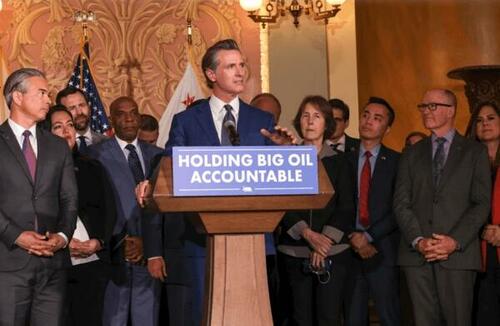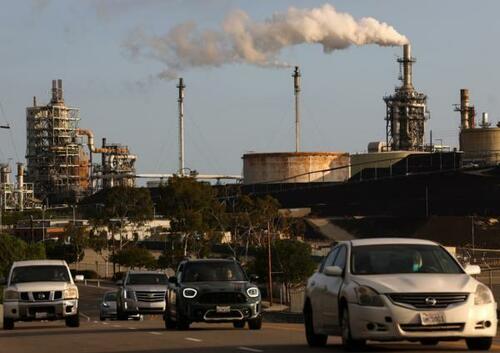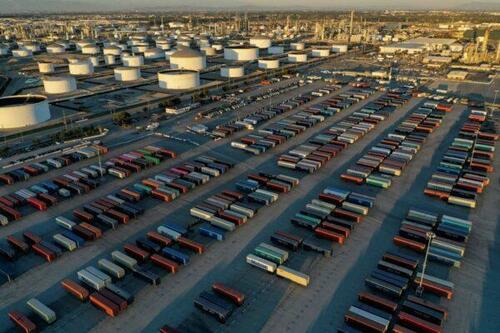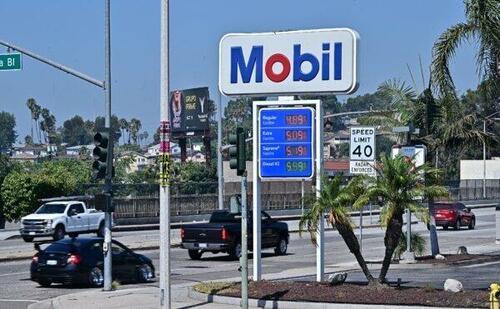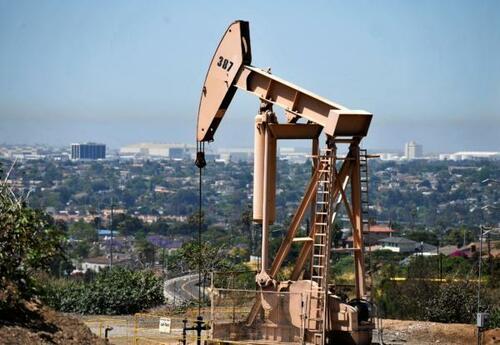California's Regulations, Not Price Gouging, Cause High Gas Prices, USC Study Finds
Authored by Jill McLaughlin via The Epoch Times,
Gov. Gavin Newsom stands behind his claim that “Big Oil” is responsible for California’s higher gas prices and vowed on April 1 to continue his fight against the industry. The pledge comes after new research put the blame on state regulations and policies for the high prices at the pump.
California’s Democratic leaders have come out strongly against the oil industry in recent years, saying the companies’ gouging was causing record-high gas prices.
“Gov. Newsom has done more than any other governor in recent history to tackle the challenge of rising gas prices—despite what the oil industry and its allies say,” a spokesman for Newsom told The Epoch Times in an email Tuesday.
A new study published March 16 by Michael Mische from the Marshall School of Business at the University of Southern California says the evidence contradicts Newsom. Mische’s research indicated California’s high gas prices were caused by the state’s regulations and policies.
“There is no economic data to support the allegation of price gouging,” Mische told The Epoch Times. “It just doesn’t exist.”
The professor also pushed back against Newsom’s claim that he was an industry ally.
“The data is the data,” Mische said.
Mische has been on the USC faculty since 1997, where he coordinates the business school’s management consulting undergraduate and graduate programs.
In March 2023, the governor signed a “windfall-profits penalty law” to target oil companies. The new law created a slew of regulations and extensive oversight for oil companies.
Newsom’s office said the governor saved Californians billions of dollars at the pump by signing the law.
The measure allows the governor’s appointed Energy Commission to fine and penalize oil companies if they earned profits beyond state-imposed limits.
California Gov. Gavin Newsom speaks in the Capitol rotunda in Sacramento on March 28, 2023. Courtesy of the Office of Gov. Gavin Newsom
The legislation also created a watchdog agency within the Energy Commission and appointed a Department of Justice prosecutor, Tai Milder, to oversee it.
“And with last year’s special session on gas price spikes, we have more tools on the way, including requiring oil refineries to maintain adequate supply to protect the state from supply-driven price spikes,” Newsom’s spokesman said Tuesday. In October, the governor signed a bill allowing the state to require that refiners keep a minimum inventory.
Study Show High Prices ‘Largely Self-inflicted’
According to the USC study, which included up to 50 years of data, California’s high gasoline prices and supply problems are “largely self-inflicted, and the result of directed policies and a litany of regulations, taxes, fees, and costs.”
“The economic evidence is abundant; California refiners have not engaged in widespread price gouging, profiteering, price manipulation, ‘unexplained residual prices’ or surcharges, magical or otherwise,” Mische wrote in the report.
Vehicles pass the Phillips 66 Los Angeles Refinery in Wilmington, Calif., on Nov. 28, 2022. Mario Tama/Getty Images
“The Golden State’s gasoline price dilemma is the result of the complex interactions of regulatory and political policies, and the subtleties of refinery operations and global crude oil prices and in-state centric supply and demand,” he added.
The state’s aggressive environmental policies are a major contributor, the report said. These include the state’s cap-and-trade charge for the industry that is passed down to the consumer. Environmental fees add about 51 cents per gallon of gas, according to the report. The state’s reporting and compliance costs are also high, which adds to the retail price of gasoline, including the state’s required special summer blend gasoline.
California also charges the highest excise tax in the nation, which along with local taxes and other program costs, increase prices at the pump, according to Mische.
Cargo shipping containers are seen adjacent to storage tanks at Marathon Petroleum's Los Angeles Refinery in Carson, Calif., on March 11, 2022. Reuters
Operating and refinery costs are also higher in California, he said.
The number of California refineries has also dropped by nearly 70 percent since 1984, from 43 to 13, Mische noted in the report.
The combination of regulations, taxes, and requirements placed on the oil and gas industry have driven up prices and taken a toll on the average working Californian who needs to drive to work, according to Mische.
“The issue is, we have Californians who are suffering,” Mische said. “They are feeling the squeeze and they’re going to feel more of the squeeze. We already have the highest cost of living in the United States. This just adds more burden onto the back of the consumer, and we can fix it.”
Vehicles pass a gas station in Rosemead, Calif., on Sept. 23, 2024. Frederic J. Brown/AFP
California is the second largest consumer of petroleum in the United States but produces less than 3 percent of the nation’s supply, the study found.
To meet the needs of drivers, utilities, and industry, the state is highly dependent on oil imports. California’s imports have increased significantly from Saudi Arabia and Iraq, and other petrostates such as Brazil, Guyana, and Ecuador, according to the report.
Nevada gas prices also hinge on California refineries, as the Silver State’s retailers get most of their supply from the state next door.
The study’s results were no surprise to industry and political leaders who are critics of Newsom’s stance on the industry.
Catherine Reheis-Boyd, director of the Western Petroleum Association in Los Angeles, said the study backs up what the association has said for years.
“It’s no secret that California has gotten in its own way when it comes to high [gas prices] and supply challenges,” Reheis-Boyd posted on X March 20.
Rigs extract oil in Culver City, Calif., on May 16, 2008. Gabriel Bouys/AFP via Getty Images
State Senate Republican Leader Brian Jones, of Santee, said 83 percent of California voters agree that gas prices are too high.
Jones told The Epoch Times in an email, “Despite knowing what’s driving costs up, Democrats refuse to fix their mistakes. In fact, they continue to double down on their war against our wallets and raise prices at the pump.”
California had the highest gas prices in the nation Tuesday, with an average of $4.85 per gallon, according to the American Automobile Association (AAA).
The national average was $3.20, AAA reported.
The second most costly gas could be found in Hawaii, where consumers paid an average of $4.52, AAA reported.
“We now know the reason our prices are $1.65 higher than the national average,” Jones added.
“Enough with the political grandstanding and games. It’s time to get to work and finally lower these prices.”
Another report, published March 18 by the Los Angeles Economic Development Corporation (LAEDC), titled “Oil and Gas in California,” shows California’s oil and gas industry is essential to the state’s economy.
“Despite facing significant challenges, including regulatory pressures, market fluctuations, and global geopolitical tensions, the industry has continued to provide critical economic, employment, and fiscal benefit across the state,” the report stated.
The data used in the report was from 2022—the same year that the governor vowed to punish “Big Oil” for allegedly “price gouging.”



